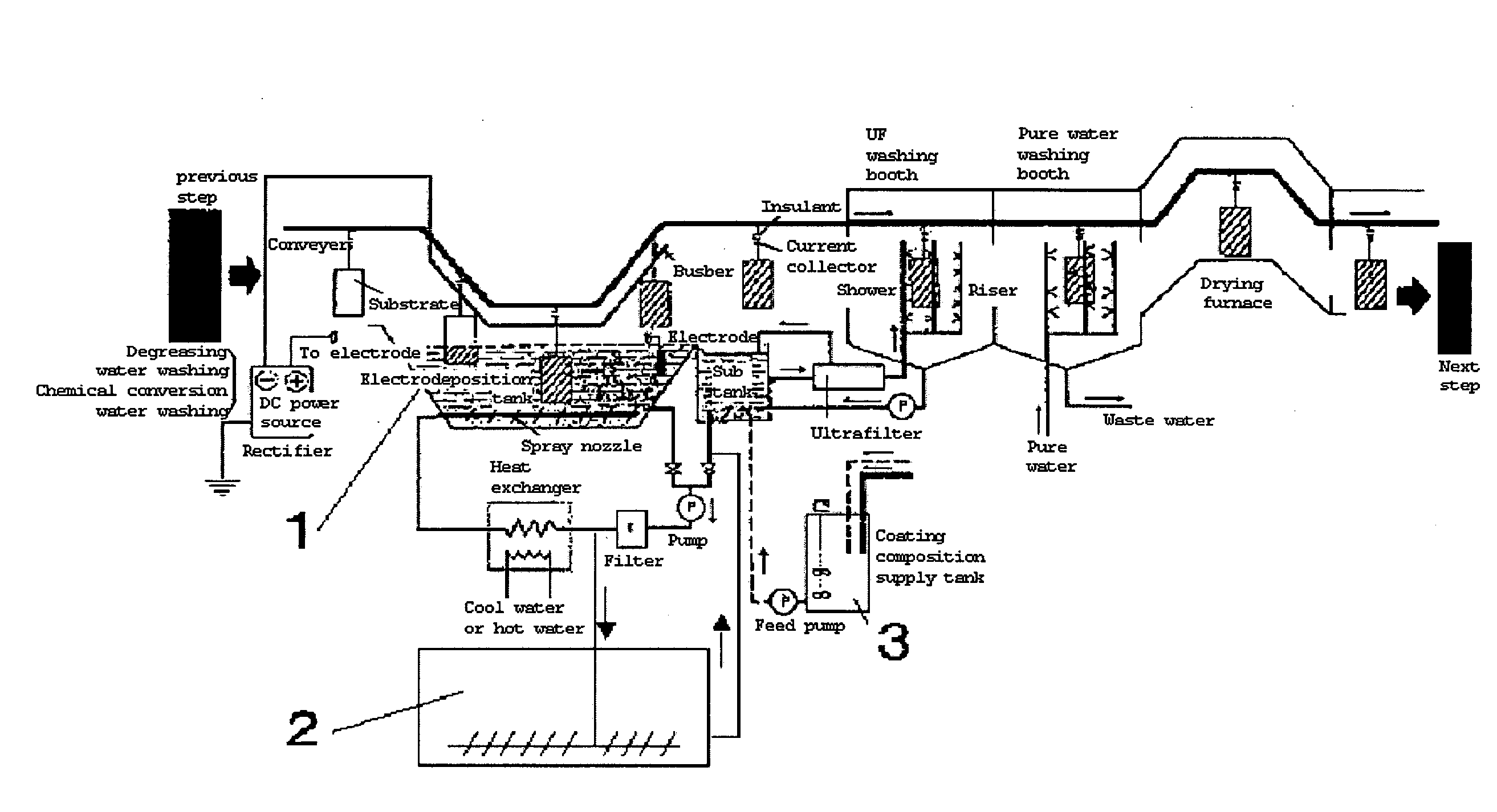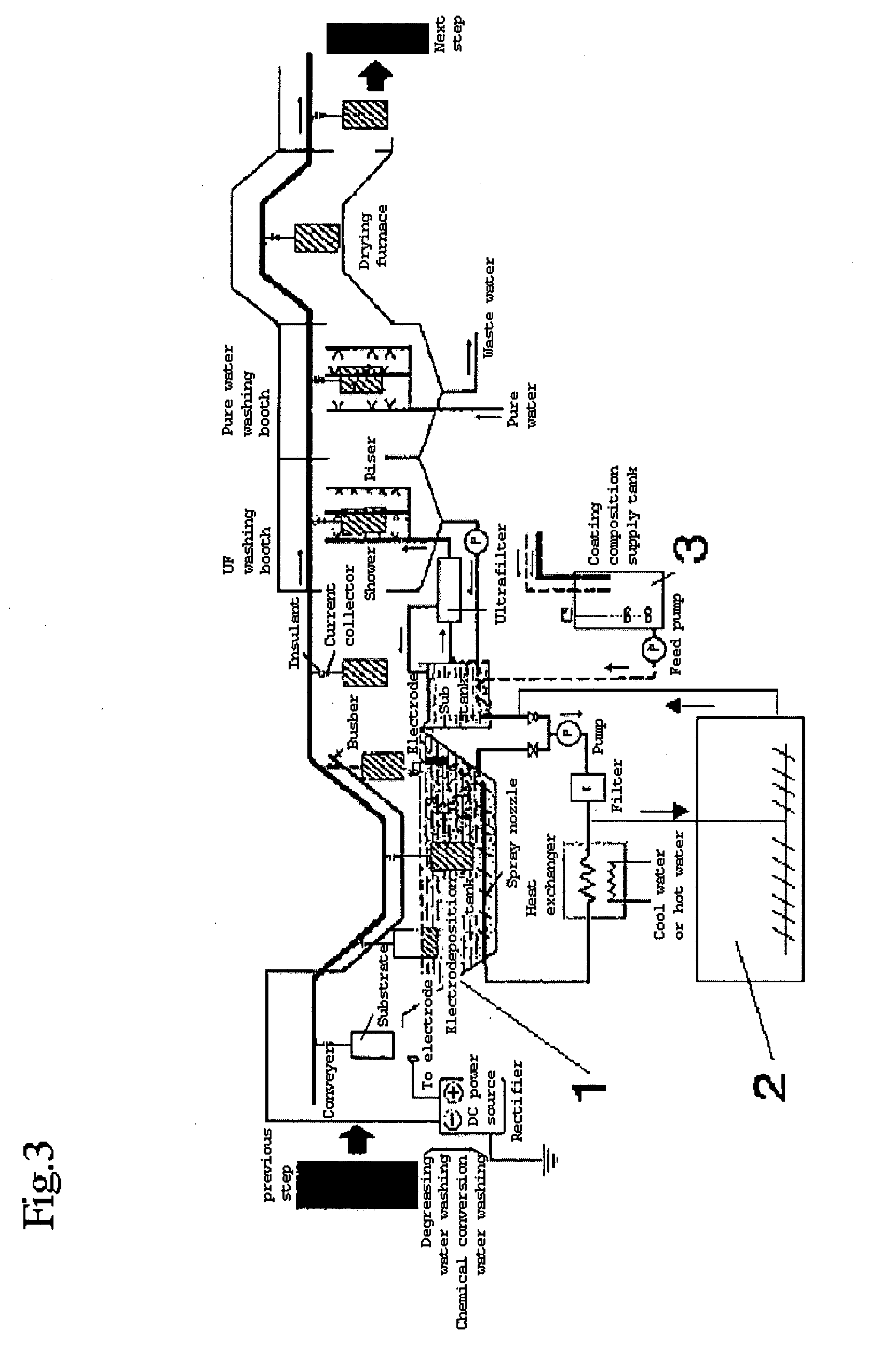Method for forming multilayer coating film and coated article
a coating film and multi-layer technology, applied in the direction of electrophoretic coatings, electrolytic organic material coatings, liquid/solution decomposition chemical coatings, etc., can solve the problems of inability to achieve adequate corrosion resistance and finish. , to achieve the effect of excellent finish, process streamlining and corrosion resistan
- Summary
- Abstract
- Description
- Claims
- Application Information
AI Technical Summary
Benefits of technology
Problems solved by technology
Method used
Image
Examples
production example 1a
Amino Group-Containing Epoxy Resin Solution No. 1A
[0178]In a separable flask with an inner volume of 2 l equipped with a thermometer, reflux condenser and stirrer, 602 parts of jER828EL (trade name of an epoxy resin produced by Japan Epoxy Resins Co., Ltd.), 178 parts of bisphenol A, 107 parts of PEG-400 (Note 1A) and 0.2 part of dimethylbenzylamine were added and reacted at 170° C. until the epoxy equivalent reached 800.
[0179]Next, 250 parts of ethylene glycol monobutyl ether and 113 parts of diethanolamine were added and the resultant mixture was allowed to react at 120° C. for 4 hours to obtain amino group-containing epoxy resin solution No. 1 having a resin solid content of 80 mass %. The obtained amino group-containing epoxy resin had an amine number of 60 mgKOH / g, a number average molecular weight of 1,900, and a proportion (%) of poly(oxyalkylene) chains of 10 mass %.
production examples 2a and 3a
Amino Group-Containing Epoxy Resin Solutions No. 2A and No. 3A
[0180]Amino group-containing epoxy resin solutions No. A2 and No. A3 were obtained in the manner of Production Example 1A except that the formulations were as shown in Table 1A.
TABLE 1AProd. Ex.Prod. Ex.Prod. Ex.1A2A3AAmino group-containing epoxyNo. 1ANo. 2ANo. 3Aresin solutionFormulationjER828EL602575626Bisphenol A178113235PEG-400 (Note 1A)10720522Diethanolamine113107117Ethylene glycol250250250monobutyl etherCharacteristicAmine number605762value(mgKOH / g)Number average190020001800molecular weightSolid content808080Proportion (%) of10202polyoxyalkylene chain (i)The formulations are expressed by parts by mass.Note 1APEG-400: Trade name of polyethylene glycol, molecular weight 400, produced by Sanyo Chemical Industries, Ltd.
Production Examples of Amino Group-Containing Epoxy Resin (A) Using (Poly)oxyalkylene Adduct (a12) of Bisphenol A
production example 4a
Amino Group-Containing Epoxy Resin Solution No. 4A
[0181]In a flask with an inner volume of 2 l equipped with a thermometer, reflux condenser and stirrer, 536 parts of jER828EL, 85 parts of bisphenol A, 279 parts of Newpol BPE-60 (Note 2A) and 0.8 part of tetrabutylammonium bromide were added and reacted at 180° C. until the epoxy equivalent reached 870.
[0182]Next, 250 parts of ethylene glycol monobutyl ether and 100 parts of diethanolamine were added and the resultant mixture was allowed to react at 120° C. for 4 hours to obtain amino group-containing epoxy resin solution No. 4A having a resin solid content of 80%.
[0183]The obtained amino group-containing epoxy resin No. 4A had an amine number of 54 mg / KOH / g, a number average molecular weight of 2,000, and a proportion (%) of poly(oxyalkylene) chains of 15 mass %.
PUM
| Property | Measurement | Unit |
|---|---|---|
| voltage | aaaaa | aaaaa |
| voltage | aaaaa | aaaaa |
| pH | aaaaa | aaaaa |
Abstract
Description
Claims
Application Information
 Login to View More
Login to View More - R&D
- Intellectual Property
- Life Sciences
- Materials
- Tech Scout
- Unparalleled Data Quality
- Higher Quality Content
- 60% Fewer Hallucinations
Browse by: Latest US Patents, China's latest patents, Technical Efficacy Thesaurus, Application Domain, Technology Topic, Popular Technical Reports.
© 2025 PatSnap. All rights reserved.Legal|Privacy policy|Modern Slavery Act Transparency Statement|Sitemap|About US| Contact US: help@patsnap.com



